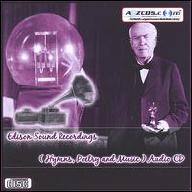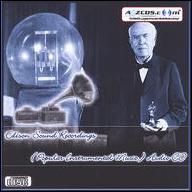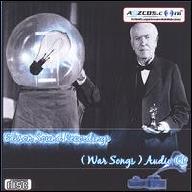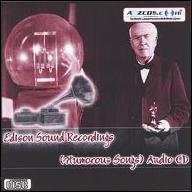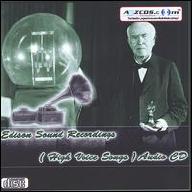In the summer of 1877, Edison was looking into ways to develop a device that would compete with the telephone just patented by his arch rival, Alexander Graham Bell. Working with ticker tape, a vibrating stylus, and the membrane from Bell's phone, Edison was looking for an alternate way to communicate over telegraph lines. Whatever he was attempting at this point didn't work out, but he later recalled that he was distracted by the musical sounds that the indented tape made as it passed through a spring, resembling the sound of speech. Edison also noted that the indentations made in the ticker tape by the wagging stylus left a trace of vibration that followed a recognizable pattern.
How Edison got from that to the phonograph is unclear. Conventional wisdom asserts that by August 13, 1877 Edison submitted a sketch of the first phonograph to machinist John Kreusi, who completed building the first model in about a month's time. The hasty Edison sketch often reproduced as the "first phonograph design" is probably not the one that Edison really used; that was likely mislaid, and a later sketch was drawn up quickly in order to protect Edison's patents.
Edison unveiled the phonograph to reporters from Scientific American in the spring of 1878, and thereafter coordinated a tour in cities across the country, where either Edison himself or his employees led demonstrations of the phonograph's capabilities in local lecture halls. Edison would later claim that for the first words spoken into the phonograph he utilized "a little piece of practical poetry: Mary had a little lamb, its fleece was white as snow." Audience members at these assemblies shouted obscenities into the phonograph, hoping to "trick" it, but it merely played back all the obscenities, recitations, cornet solos, and anything else that was thrown into its little mouthpiece. The American public was astounded!
The first phonograph, which was merely a hand-cranked, grooved cylinder mandrel covered with a thin sheet of tinfoil, was surprisingly versatile despite its simplicity -- it could be played backwards, and was capable of primitive overdubs. However it had one major drawback; the recordings it made weren't permanent. Once the tinfoil wore out, generally after about five plays, or the tinfoil sheet was removed from the mandrel, the recording made was effectively destroyed. Edison had hoped to market the phonograph as an office dictation device, but for it to be truly practical for that purpose Edison's cylinder would have to be able to play the recording many more times. After the novelty of the phonograph wore off in early 1879, Edison found no backers for further development. So he went back to the drawing board in hopes of finding a "better idea," and later in the year, invented the incandescent light.
Exploiting this new invention kept Edison quite busy for a longtime, and a period of some five years passed where there were no new developments in regard to the phonograph. But in 1884, Alexander Graham Bell's nephew, Chichester Bell, and Charles Sumner Tainter began to work in secret on an improved phonograph, which used wax cylinders in place of the tinfoil. The cylinders could be removed from the phonograph without being damaged and held their recordings intact for a hundred plays or more. Bell and Tainter apprised Edison of their discoveries and offered to pool their patents with his to expedite exploitation of the new phonograph. But an angry Edison would hear nothing of it, and early in 1888 he and his top engineers conducted several sleepless days and nights of investigation into improving Edison's "favorite invention." A battery was added to power the motor and other improvements were made. Beginning in the summer of 1888, Edison sent his men to Europe on a quest to collect testimonial recordings of the most distinguished figures from abroad. Handel's music was recorded at the Crystal Palace in London, as were the voices of Queen Victoria and composer Sir Arthur Sullivan. The piano playing of composer Johannes Brahms was recorded in Berlin. Edison also collected testimonials from men in the State Department in Washington, D.C., who were using the phonograph on an experimental basis to transcribe Senate hearings on a scandal involving the New York Port Authority.
All of these achievements helped greatly to enhance the prestige of the lowly phonograph, but the business side of the operation still moved at a snail's pace. Jesse Lippincott, a wealthy financier known to Edison, secured Bell and Tainter's patents in 1888, and afterward a stubborn Edison finally relented to go in with Lippincott. In the spring of 1889, The North American Phonograph Company was established, and the American recording industry was finally born, nearly twelve years after the device had first appeared in Edison's lab!
In 1890, you couldn't just go out to one of Edison's North American branch offices and buy a phonograph, unless you were a corporate executive seeking one for use in dictation. Very early phonographs intended for public entertainment were coin operated and initially set up in dancehalls and drinking establishments as an amusement. Damage to equipment and frequent service calls proved costly, and as a result Cincinnati-based Edison jobber James Andem devised the idea of installing the machines in an arcade that would be manned by a full-time staff. The first such arcade opened in Cleveland in September 1890, and proved quite profitable. Most other regional Edison offices followed suit in short order.
Although Edison didn't know it, the elements that led to his fall from dominance in the recording industry were already underway from the very start of his involvement in it. In 1889 or 1890, inventor Emile Berliner began to develop a flat-disc type record. Ironically his first recorded selection would be Twinkle, Twinkle Little Star, demonstrating that Berliner's taste in "practical poetry" was similar to Edison's own! Berliner's flat disc record was five inches in diameter (the same size as today's compact disc), played for just under two minutes, and made its modest bow in the Washington, D.C., area in 1895.
At this time Edison began to experience trouble from breakaway regional divisions, most potently from the Maryland-Delaware-Washington, D.C., subsidiary, which declared itself independent and renamed itself The Columbia Phonograph Company in 1896. Edison sued Columbia, but somehow the company managed to survive. This set up a domino effect within North American that caused it to collapse by 1898. The arcade business was falling off anyway, and Edison was forced to shift his focus to marketing phonographs for home use. He could not do so cheaply, and Edison refused to compromise in terms of both the quality of his phonographs and their cost. So it was easy to undercut his business, and infringers were legion. One by one Edison took them to court, and he usually won.
But try as he might, Edison could not win an infringement suit against manufacturers of flat disc records. Berliner's invention was received with indifference in America upon its first launch, as it was little more than a toy and put out such poor sound. But in Europe, where there was practically no phonograph industry and, most significantly, Edison himself had no interests, the flat disc format was a runaway success. Flat disc records didn't sound as good as cylinders, but they were easier to store and the machines that played them were much cheaper than Edison's. By 1901, both Victor and Columbia were establishing the flat disc business in the United States, and over time, the sound of the records would improve.
Edison finally began to market a cheap Edison portable player, the "Little Gem" around 1909. He also introduced a cylinder that played for four minutes, longer than the average flat disc record of the time.
Finally, in 1912, Edison introduced "Diamond Discs," his own answer to the flat disc phenomenon. These records were "vertical cut," meaning that the grooves wagged toward and away from you, like on a cylinder, rather than from right to left, as in standard "lateral cut" recordings. The records were also injection molded, rather than "pressed" like other records. The grooves were molded into a thin Bakelite surface that was spread over a thick blank made from a mixture of china clay and wood flour. This use of Bakelite may have been the very first time plastics were utilized in American industry, and certainly it was the first time plastic was used in the production of records. Before, Edison had depended on his employees to make the selection as what to record and by whom. But now Edison himself personally listened to and approved all of his Diamond Discs. It was a pet project, to say the least. As in the case of his cylinder boxes, all Edison Diamond Discs bore his likeness and signature.
Edison really tried to reach out to the public through the Diamond Discs, to the point of giving away copies of ten of his favorite records with every machine sold. However, the public wasn't crazy about the fact that you couldn't play Edison records on other types of phonographs. While the sound on Diamond Discs was noticeably superior to that of the lateral records made by Victor and Columbia, it was also much quieter, and once the record got a little worn and the needle started playing that china clay and wood flour blank, they didn't sound that good! Alas, Edison records were heavy enough to kill a small animal if dropped on one, and their thickness made them difficult to store, just like cylinders. Diamond Discs didn't bear paper labels until about 1920, and the label information was simply etched into the black surface of the record, making it difficult to distinguish one Diamond Disc from another.
Ultimately it was Edison's micro-management of the recorded repertoire on Diamond Discs that ultimately sealed their fate. He insisted on hiring artists based on their talent and clear enunciation of lyrics, rather than their reputation with the public. With a few very significant exceptions, such as in the case of Edison records made by Sophie Tucker, Serge Rachmaninov, and Polk Miller's Old South Quartette, relatively few of the performers who recorded for Edison were known other than from the records they made. His own musical tastes were those of a man born before the civil war, and these were most decidedly out of step with a record buying public with a growing interest in ragtime, and later jazz, which Edison himself couldn't stand. Likewise he didn't care much for many of the "name" artists he recorded, referring to Rachmaninov as a "pounder."
The Edison Recording firm continued to struggle, producing Diamond Discs, cylinders, and machines, through practically the whole of the 1920s. Edison did eventually relinquish his control of what the company recorded on Diamond Disc, and the Edison Company from about 1920 forward recorded a fair amount of good jazz by artists, such as the California Ramblers and bandleader Dave Kaplan. Edison also issued the first bona fide commercial country record in 1924 when his in house tenor of longstanding Vernon Dalhart recorded The Wreck of the Old 97. However, the Edison Company was now well behind its competition technologically. In the mid-'20s, Edison experimented with a 33 rpm long-playing format on Diamond Discs that was a complete and utter disaster. Edison didn't start issuing electrically recorded items until 1926, and finally began to issue lateral cut records in 1927, when the company was on its last legs. The Thomas A. Edison record company closed its doors on March 29, 1929 and not a moment too soon. The following day the stock market crashed, and with it the fortunes of his healthiest competitors were wiped out. Edison died less than two years later, though his signature continued to appear on Ediphone dictation records supplied for office use well into the 1970s. The dictation division of Edison had been sold off, but the new owner was permitted to keep the trademark.
For someone who enjoyed such a long association with recordings, and had such a decisive impact on the industry, relatively few records exist of Edison himself. A cylinder of a Letter, made in fall of 1888, lay unnoticed in the Edison National Historic Site until discovered by researcher Jerry Fabris in the 1990s; it is the earliest known record of Edison speaking. Another discovery is an undated cylinder known as Thomas A. Edison Tells a Joke. Edison did make one commercially issued recording, Lest We Not Forget, a speech on the First World War released by his own company in 1919. He is heard briefly on Christmas Greetings From the Gang at Orange, a promotional Christmas record made as a giveaway by the Edison Company in 1920. The most famous sound byte of Edison, of him reciting Mary Had a Little Lamb, comes not from a record, but from the audio track of an experimental sound film newsreel made during the celebrations surrounding the 50th anniversary of the invention of the phonograph. ~ Uncle Dave Lewis, Rovi


